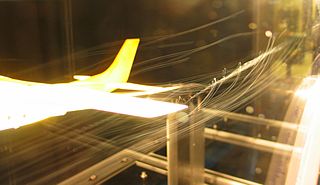| | This article includes a list of references, related reading or external links, but its sources remain unclear because it lacks inline citations. Please improve this article by introducing more precise citations where appropriate. (April 2009) |

Flow visualization in fluid dynamics is used to make the flow patterns visible, in order to get a qualitative or quantitative information on them.
Contents[hide]
|
[edit] Overview
Flow visualization is the art of making flow patterns visible. Flow visualization can be appreciated on several levels. Most fluids (air, water, etc.) are transparent, thus their flow patterns are invisible to us without some special methods to make them visible.
On another level, we know the governing equations of fluid motion (the Navier-Stokes equations), but they are nonlinear partial differential equations with very few general solutions of practical utility. We can solve them numerically with modern computer methods, but these solutions may not correspond to nature unless verified by experimental results.
On still another level the Navier-Stokes equations are pattern generators, and natural fluid flows display corresponding patterns that can recur on scales differing by many orders of magnitude. Such fluid patterns are familiar to almost everyone: the bathtub vortex and the tornado, the smoke ring and the mushroom cloud, the swinging of wires in the wind and the collapse of a historic bridge due to forced oscillations from vortex shedding.
[edit] Methods of visualization

In experimental fluid dynamics, flows are visualized by three methods:
- Surface flow visualization: This reveals the flow streamlines in the limit as a solid surface is approached. Colored oil applied to the surface of a wind tunnel model provides one example (the oil responds to the surface shear stress and forms a pattern).
- Particle tracer methods : Particles, such as smoke, can be added to a flow to trace the fluid motion. We can illuminate the particles with a sheet of laser light in order to visualize a slice of a complicated fluid flow pattern. Assuming that the particles faithfully follow the streamlines of the flow, we can not only visualize the flow but also measure its velocity using a method known as particle image velocimetry.
- Optical methods : some flows reveal their patterns by way of changes in their optical refractive index. These are visualized by optical methods known as the shadowgraph, schlieren photography, and interferometry.
[edit] Application
In computational fluid dynamics the numerical solution of the governing equations can yield all the fluid properties in space and time. This overwhelming amount of information must be displayed in a meaningful form. Thus flow visualization is equally important in computational as in experimental fluid dynamics.
[edit] See also
- Scientific visualization
- Streamlines, streaklines and pathlines
[edit] References
- Merzkirch, W., Flow visualization, New York:Academic Press, 1987.
- Van Dyke, M., An album of fluid motion, Stanford, CA:Parabolic Press, 1982.
- Samimy, M., Breuer, K. S., Leal, L. G., and Steen, P. H., A gallery of fluid motion, Cambridge University Press, 2004.
- Settles, G. S., Schlieren and shadowgraph techniques: Visualizing phenomena in transparent media, Berlin:Springer-Verlag, 2001.
No comments:
Post a Comment